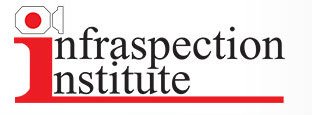
THERMOGRAPHY LEVEL I CERTIFICATION CLASS
Invizions, Inc. now offers training in Certified Infrared Thermography. Training and certification through Infraspection Institute can be taught at your facility or at one of the specific training sites. Read about it and view the course curriculum. If you have any questions or are interested in setting up a training session, contact us right away.
Level I Certified Infrared Thermographer® is a five-day course for the application of qualitative thermal imaging for P/PM, Condition Assessment, Condition Monitoring, Quality Assurance, Forensic Investigations, and Building Sciences.
This course covers infrared theory, heat transfer concepts, equipment operation and selection, standards compliance, image analysis and report generation.
Students are trained to identify and document thermal patterns caused by improper design, workmanship or material failure. Specific applications include: electrical distribution systems, mechanical systems, steam systems, refractory systems, underground piping, active thermography, building envelopes and flat roofs.
Course tuition includes all course presentations, Student Reference Manual, and Infraspection Institute Certified Infrared Thermographer® exam. Certification card and diploma issued with passing grade of 80%. Course is approved by the InterNational Association of Certified Home Inspectors and meets the training requirements for their Infrared Certified professional designation and logo.

Contact Invizions, Inc. for more information.

Course Curriculum
CERTIFIED INFRARED THERMOGRAPHY
-
Heat transfer
Electromagnetic spectrum
Emittance, reflectance, and transmittance
Atmospheric transmission
IR wavebands and lens materials
-
Selection criteria
Range and level settings
Class demonstrations
Manufacturer equipment presentations (optional)
Hands-on use in class
-
Theory and thermal signatures of problems
Seven types of detectable defects
Conducting an inspection
Safety practices
Confirming exceptions
Data recording
Standards for inspections
-
Theory and thermal signatures of problems
Rotating equipment
Power transmission components
High-temperature insulation
Steam systems, process equipment, heat exchangers, storage vessels
Active thermographic inspection techniques
Safety practices
Confirming exceptions
Data recording
Standards for inspections
-
Theory and component construction
Insulation and material characteristics
Inspection techniques
Ground based / aerial
Weather variables and influences
Required site conditions
Safety practices
Thermal signatures of latent moisture
Verification of data
Data recording
Alternate methods of moisture detection
Standards for inspections
-
Theory and component construction
Insulation and material characteristics
Inspection techniques
interior / exterior
Weather variables and influences
Required site conditions
Creating sufficient Delta T
Thermal signatures
Missing & damaged insulation
Air leakage
Latent moisture
Pest damage
Mold detection
Other tools
Verification of data
Data recording
Standards for inspections
-
9 steps to setting up a program
Integrating with other predictive technologies
Cross-verifying with other predictive technologies
Why programs fail, how they succeed
Generating standards compliant reports







